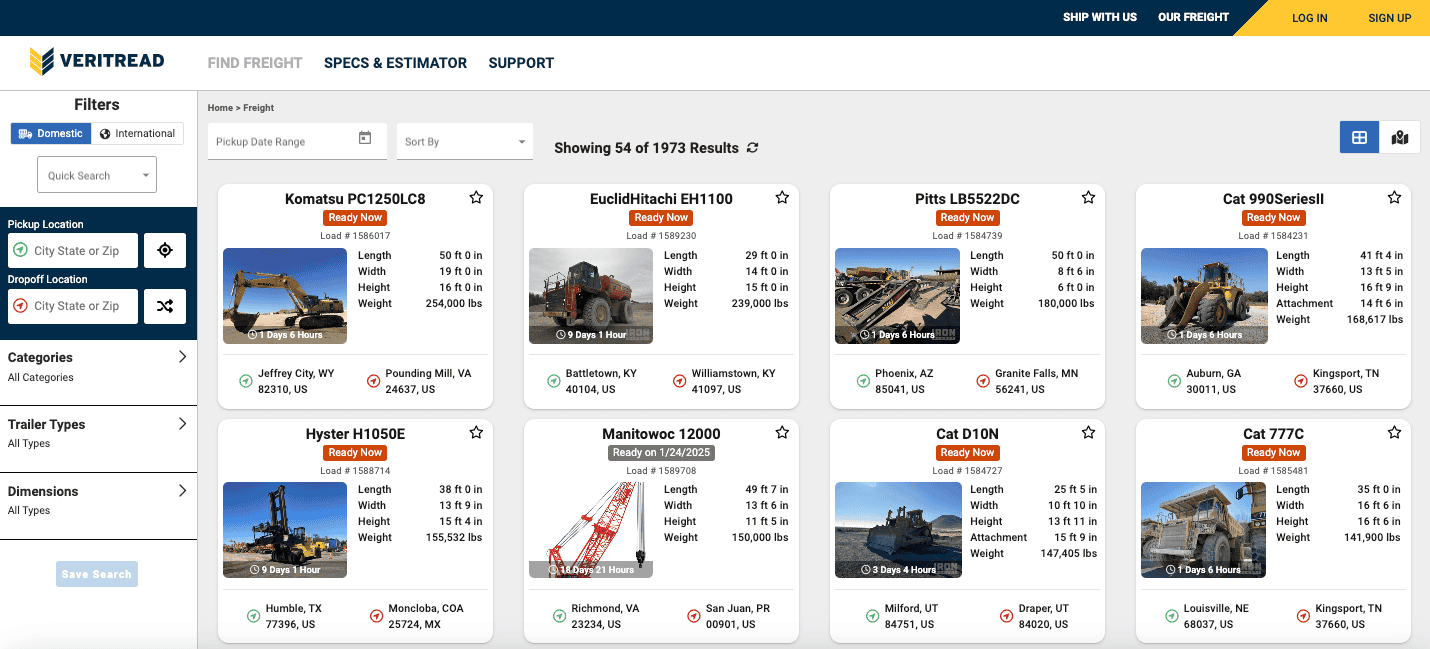Heavy Haul Route Planning and Their Challenges

Embarking on a heavy haul transportation journey can be an exhilarating yet demanding experience. Whether you’re transporting oversized machinery, construction equipment, or industrial components, the success of your haul largely depends on effective route planning. Beyond just getting from point A to point B, heavy haul route planning is a meticulous process that requires careful consideration of numerous factors to ensure a safe and smooth journey.
In this comprehensive guide, we will delve into the world of heavy haul route planning and equip you with valuable insights and practical tips to make efficient routes. From understanding the importance of route planning to identify potential obstacles, leveraging resources, and tackling weather challenges, we’ll cover everything you need to know to become a seasoned heavy haul route planner. So buckle up as we set out on a journey to optimize your heavy haul transportation!
Outline:
- Why is Route Planning Important for Heavy Haul Transportation?
- What Factors Should be Considered When Planning a Heavy Haul Route?
- How Can I Identify and Avoid Potential Obstacles During Heavy Haul Transport?
- Are There Any Tools or Resources Available to Assist With Heavy Haul Route Planning?
- How Do I Account for Weather Conditions and Other Unforeseen Challenges in My Route Plan?
Why is Route Planning Important for Heavy Haul Transportation?
Route planning is important for heavy haul transportation for a number of reasons, including:
- To ensure that the load can safely navigate the route. Heavy haul loads are often large and oversize, which means that they may not be able to fit on all roads or bridges. Route planning helps to identify the safest and most efficient routes for these loads.
- To minimize delays. Heavy haul loads can often cause traffic delays, so it is important to plan the route carefully to minimize these delays. This may involve avoiding peak traffic times or taking alternate routes.
- To comply with regulations. There are often specific regulations that need to be followed when transporting heavy haul loads. Route planning helps to ensure that these regulations are met.
- To reduce costs. By carefully planning the route, heavy haul operators can often reduce costs by avoiding tolls, traffic congestion, and other unnecessary expenses.
In addition to these reasons, route planning can also help to improve customer satisfaction by ensuring that loads are delivered on time and in good condition.
What Factors Should be Considered When Planning a Heavy Haul Route?
Here are some of the factors that should be considered when planning a heavy haul route:
- The size and weight of the load: This will determine the type of vehicles that can be used and the routes that are available.
- The height and width of the load: This will determine whether the load can fit under bridges or through tunnels.
- The weight restrictions of bridges and roads: Heavy haul loads may not be able to travel on roads with weight restrictions.
- The clearance requirements of bridges and tunnels: Heavy haul loads may not be able to travel under bridges or through tunnels with low clearance.
- The traffic conditions: Heavy haul loads can cause traffic delays, so it is important to plan the route around peak traffic times.
- The weather conditions: Heavy haul loads may not be able to travel in certain weather conditions, such as heavy rain or snow.
- The availability of permits: Some routes may require permits, so it is important to check with the appropriate authorities before planning the route.
- The cost of the route: The cost of the route will vary depending on the factors mentioned above, as well as the distance of the route.
- The availability of escort vehicles: In some cases, escort vehicles may be required to help guide the load along the route.
- The experience of the driver: The driver of the heavy haul load must be experienced in transporting these types of loads and be familiar with the route.
By carefully considering all of these factors, heavy haul operators can develop safe and efficient routes for their loads.
How Can I Identify and Avoid Potential Obstacles During Heavy Haul Transport?
Here are some tips on how to identify and avoid potential obstacles during heavy haul transport:
- Plan the route carefully: This includes considering the size and weight of the load, the height and width of the load, the weight restrictions of bridges and roads, the clearance requirements of bridges and tunnels, the traffic conditions, the weather conditions, the availability of permits, and the cost of the route.
- Use a routing software: There are a number of routing software programs that can be used to help plan heavy haul routes. These programs can take into account all of the factors mentioned above and help to identify the safest and most efficient routes.
- Consult with a professional: If you are unsure about how to plan a heavy haul route, you may want to consult with a professional who specializes in this type of transportation. They will be able to help you identify the best route for your load and ensure that all of the necessary permits and approvals are obtained.
- Communicate with the customer: It is important to keep the customer informed of the progress of the shipment and any potential delays. This will help to manage their expectations and ensure that they are satisfied with the service.
- Inspect the route: Before the heavy haul transport begins, it is important to inspect the route to identify any potential obstacles. This includes looking for low clearance bridges, narrow roads, and other hazards that could damage the load or delay the transport.
- Use escort vehicles: In some cases, escort vehicles may be required to help guide the load along the route. Escort vehicles can help to warn other drivers of the heavy haul load and help to keep the load safe.
- Monitor the weather: The weather can also be a potential obstacle for heavy haul transport. If there is bad weather, such as heavy rain or snow, it may be necessary to delay the transport or take a different route.
- Use caution: When transporting heavy haul loads, it is important to use caution at all times. This includes driving slowly and carefully, and being aware of the surroundings.
Are There Any Tools or Resources Available to Assist With Heavy Haul Route Planning?
Yes, there are a number of tools and resources available to assist with heavy haul route planning. These include:
- Routing software: There are a number of routing software programs that can be used to help plan heavy haul routes. These programs can take into account all of the factors mentioned above and help to identify the safest and most efficient routes. Some popular routing software programs for heavy haul route planning include:
- Route4Me: This software offers a variety of features for heavy haul route planning, including the ability to account for weight restrictions, clearance requirements, and traffic conditions.
- Optimatics: This software is designed for businesses that need to plan complex routes for heavy haul loads. It offers a variety of features, including the ability to track the progress of shipments and generate reports.
- Manhattan Associates: This software is designed for businesses that need to plan routes for a variety of different types of loads, including heavy haul loads. It offers a variety of features, including the ability to generate reports and track the progress of shipments.
- Online tools: There are a number of online tools that can be used to help plan heavy haul routes. These tools are typically less expensive than routing software programs, but they may not offer as many features. Some popular online tools for heavy haul route planning include:
- Google Maps: This tool can be used to plan routes for any type of load, including heavy haul loads. It offers a variety of features, including the ability to view traffic conditions and get turn-by-turn directions.
- Waze: This tool is similar to Google Maps, but it also offers real-time traffic information from other users. This can be helpful for planning heavy haul routes, as it can help you to avoid congested areas.
How Do I Account for Weather Conditions and Other Unforeseen Challenges in My Route Plan?
Weather conditions and other unforeseen challenges can have a significant impact on heavy haul route planning. Here are some tips on how to account for these factors in your route plan:
- Check the weather forecast: Before you start planning your route, check the weather forecast for the day of the transport and the days leading up to it. This will help you to identify any potential weather conditions that could impact your route.
- Plan for multiple routes: If you are concerned about weather conditions, it is a good idea to plan multiple routes. This will give you flexibility if you need to change your route due to bad weather.
- Be flexible: It is important to be flexible when planning a heavy haul route. There may be unexpected delays or road closures that you will need to be prepared for.
Why Join VeriTread As A Transport Provider?
VeriTread has 100’s of loads that you won’t find anywhere else with new loads listed every day. When you complete a profile on VeriTread, we learn detailed information about your equipment, your capabilities, and the areas you service. We combine this information with our patent pending freight matching technology to proactively find you the best paying freight available. VeriTread is reserved only for carriers, brokers, and forwarders, who are properly bonded, licensed, and insured which reduces overall risk as well as keeps rates at a fair and profitable level.
veritread products
Top Articles
Freight Types
recent posts

Basic Tips of Heavy Equipment Transport

Understanding Equipment Transport Services



